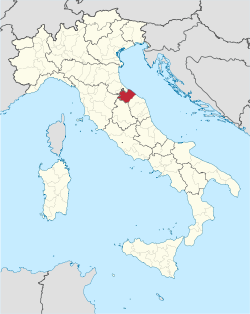Province of Pesaro and Urbino
| Province of Pesaro e Urbino | |
|---|---|
| Province | |
 Map highlighting the location of the province of Pesaro e Urbino in Italy |
|
| Country |
|
| Region | Marche |
| Capital(s) | Pesaro |
| Comuni | 60 |
| Government | |
| • President | Daniele Tagliolini (PD) |
| Area | |
| • Total | 2,564.21 km2 (990.05 sq mi) |
| Population (2009-7-31) | |
| • Total | 364,896 |
| • Density | 140/km2 (370/sq mi) |
| Time zone | CET (UTC+1) |
| • Summer (DST) | CEST (UTC+2) |
| Telephone prefix |
0721 Pesaro 0722 Urbino |
| Vehicle registration | PU |
| ISTAT | 041 |
| Website | www |
0721 Pesaro
The Province of Pesaro and Urbino (Italian: Provincia di Pesaro e Urbino, pronounced [proˈvintʃa di ˈpeːzaro e urˈbiːno]) is a province in the Marche region of Italy. Its capital is the city of Pesaro. It also borders the state of San Marino. The province is surrounded by San Marino and Emilia Romagna in the north, Umbria and Tuscany in the west, Ancona in the south and the Adriatic Sea on the east. The province is also known as "Riviera of Hills". It is mostly covered by hills and is popular for its beaches. The Ceramics museum and the Biblioteca Oliveriana are located in the capital city. The County Council is based in Pesaro while the headquarters of the provincial administration are in Urbino. The coat of arms of the province consists of a shield divided into two parts, each part is given the coat of arms of the two capitals. It has a robust economy with low unemployment, based on craft and small and medium industries, agriculture, tourism, resorts and cultural center. It has a very low per capita energy consumption. The art and craft industry contributes to 22% of the province's GDP. Tourism in the province plays a primary role in the local economy, the main attractions are the sea and the Apennines. The beaches of Gabicce Mare, Pesaro, Fano and Marotta are the most famous ones.
Just outside Pesaro, in the little hamlet of Santa Venerada, close by the chapel Chiostro di Santo Gaetano is the Lucus Pisaurensis, the Sacred Grove of Pisaurum, ancient Pesaro.
Early Roman History
...
Wikipedia
